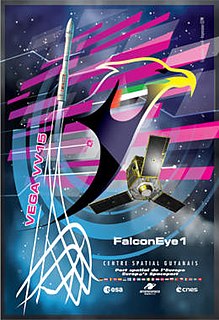 CNES CSG poster artwork | |
| Vega launch | |
|---|---|
| Launch | 29 April 2021, 01:50 UTC [1] [2] |
| Operator | Arianespace |
| Pad | ELV |
| Payload | |
| Outcome | Success |
| Vega launches | |
Vega flight VV18 was the 18th launch of the Vega rocket. [1]
 CNES CSG poster artwork | |
| Vega launch | |
|---|---|
| Launch | 29 April 2021, 01:50 UTC [1] [2] |
| Operator | Arianespace |
| Pad | ELV |
| Payload | |
| Outcome | Success |
| Vega launches | |
Vega flight VV18 was the 18th launch of the Vega rocket. [1]
The main payload was the Pléiades Neo 3 satellite, complemented by 5 auxiliary payloads: NorSat-3, Bravo, 2 Lemur-2, and ELO Alpha. With their adapters and dispensers, the total payload mass was approximately 1,278 kilograms (2,818 lb). [1]
Pléiades Neo 3, with a launch mass of about 920 kg (2,030 lb) and a design lifetime of 8 to 10 years, was in the upper position. It was injected 54 minutes and 29 secondes after launch into its target sun-synchronous orbit at an altitude of about 628 km (semi-major axis of about 7006 km) and mean local time of the descending node approximately equal to 10:30. Pléiades Neo 3 is Airbus's 131st satellite launched by Arianespace. [1]
NorSat-3, Bravo, the 2 Lemur-2, and ELO Alpha, were in the lower position and were separated from the launcher 1 hour, 41 minutes and 52 secondes after launch into their sun-synchronous orbits at an altitude of approximately 613 km and mean local time of the descending node also approximately equal to 10:30. [1]
The flight was successfully launched from the ELV launch pad in Kourou, Centre Spatial Guyanais on 29 April 2021. [3]

Vega is an expendable launch system in use by Arianespace jointly developed by the Italian Space Agency (ASI) and the European Space Agency (ESA). Development began in 1998 and the first launch took place from the Centre Spatial Guyanais on 13 February 2012.
SEOSat-Ingenio, was a Spanish project to produce a satellite capable of providing wide-field imagery ensuring a repeat cycle of 38 days at 2.5 metre panchromatic resolution and 10 metre colour resolution, from a sun-synchronous polar orbit; it was Spain's first optical imaging satellite. The satellite was part of the Spanish Earth Observation Satellite program. The mission was funded by Spain's Centre for the Development of Industrial Technology (CDTI). SEOSat-Ingenio information was to be used by various Spanish civil, institutional or government users. However, under the Copernicus Programme of the European Union, it was also accessible to other European users, as well as to the Group on Earth observation of the Global Observing System of Earth.

Vega flight VV01 is the maiden flight of the Vega launcher. It occurred from the Centre Spatial Guyanais (CSG) on 13 February 2012 at 10:00:00 UTC.

Vega flight VV02 was the second flight of the Vega launcher. It occurred from the Guiana Space Centre on 7 May 2013 at 02:06:31 UTC.

Vega flight VV03 is the third flight of the Vega launcher. It occurred from the Guiana Space Centre on 30 April 2014 at 01:35:15 UTC.

Vega flight VV05 is the Vega space launch of the Sentinel-2A satellite.

Vega flight VV06 is the Vega space launch of the LISA Pathfinder satellite.

Vega flight VV07 is the 7th Vega space launch, of the PerúSAT-1 and 4 SkySat satellites.

Vega flight VV15 was the 15th flight of the Vega launcher, and its first failure.

Vega flight VV08 was the launch of Göktürk-1 on board the 8th flight of the Vega launcher.

Vega flight VV09 was the launch of the Sentinel-2B satellite by the 9th Vega launcher.

Vega flight VV10 was the launch of the OPTSAT-3000 & Venµs satellites by the 10th Vega launcher.

Vega flight VV11 was the launch of the Mohammed VI-A satellite by the 11th Vega launcher.

Vega flight VV12 was the launch of the ADM-Aeolus satellite by the 12th Vega launcher.

Vega flight VV13 was the launch of the Mohammed VI-B satellite by the 13th Vega launcher.

Vega flight VV14 was the launch of the PRISMA satellite by the 14th Vega launcher.

Vega flight VV16, also called SSMS PoC Flight, was the 16th launch of the Vega rocket. The launch was also notable as it was the first Vega launch following the accident of the VV15 launch in July 2019 that caused the loss of FalconEye1 satellite.

Vega flight VV17 was the 17th launch of the Vega rocket. The rocket failed after launch and the mission was lost.

Vega flight VV19 was the 19th launch of the Vega rocket.